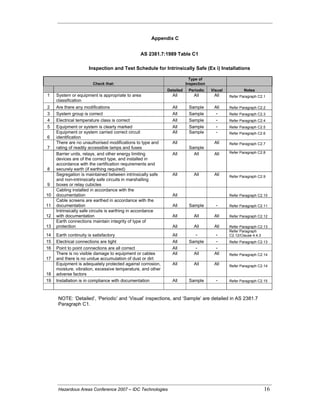A Biased View of Roar Solutions
A Biased View of Roar Solutions
Blog Article
Roar Solutions for Dummies
Table of ContentsThe Roar Solutions PDFsThe Buzz on Roar SolutionsThe smart Trick of Roar Solutions That Nobody is Talking About
In such an ambience a fire or surge is possible when three standard conditions are fulfilled. This is frequently described as the "unsafe area" or "combustion" triangle. In order to shield installations from a potential surge a method of analysing and categorizing a possibly hazardous location is called for. The objective of this is to make sure the proper option and setup of devices to ultimately protect against an explosion and to make certain safety of life.
(https://lnk.pblc.app/pub/f49b043987c7b7)
No tools should be mounted where the surface temperature level of the equipment is greater than the ignition temperature of the provided risk. Below are some common dust hazardous and their minimal ignition temperature. Coal Dust 380C 225C Polythene 420C (melts) Methyl Cellulose 420C 320C Starch 460C 435C Flour 490C 340C Sugar 490C 460C Grain Dust 510C 300C Phenolic Material 530C > 450C Aluminium 590C > 450C PVC 700C > 450C Residue 810C 570C The likelihood of the danger existing in a focus high sufficient to create an ignition will certainly vary from place to place.
In order to categorize this danger an installment is separated into areas of risk depending upon the amount of time the harmful is present. These areas are referred to as Zones. For gases and vapours and dusts and fibers there are 3 areas. Area 0 Zone 20 A harmful ambience is highly likely to be present and may be present for lengthy periods of time (> 1000 hours per year) and even continually Area 1 Area 21 A harmful environment is feasible however unlikely to be present for long durations of time (> 10 450 C [842 F] A category of T6 suggests the minimum ignition temperature level is > 85 C [185 F] Dangerous area electric tools perhaps made for use in greater ambient temperature levels. This would certainly indicated on the score plate e.g. EExe II C T3 Ta + 60C( This suggests at 60C ambient T3 will certainly not be exceeded) T1 T1, T2, T3, T4, T5, T6 T2 T2, T3, T4, T5, T6 T3 T3, T4, T5, T6 T4 T4, T5, T6 T5 T5, T6 T6 T6 A T Class rating of T1 suggests the optimum surface area temperature created by the instrument at 40 C is 450 C. Thinking the associated T Class and Temperature score for the equipment are appropriate for the area, you can constantly utilize an instrument with an extra stringent Division score than required for the location. There isn't a clear solution to this question however. It truly does depend upon the type of equipment and what repair services need to be lugged out. Equipment with specific test treatments that can not be carried out in the field in order to achieve/maintain 3rd party rating. Should return to the manufacturing facility if it is prior to the tools's service. Field Repair Service By Authorised Personnel: Complex screening might not be required nevertheless particular procedures may need to be followed in order for the devices to keep its 3rd celebration ranking. Authorized personnel should be used to execute the work appropriately Fixing must be a like for like substitute. New element must be thought about as a straight substitute needing no special screening of the devices after the fixing is complete. Each item of devices with a hazardous ranking must be assessed independently. These are detailed at a high degree listed below, however, for more thorough information, please refer straight to the standards.
Roar Solutions Fundamentals Explained
The equipment register is a detailed database of equipment records that includes a minimum collection of areas to determine each thing's location, technical criteria, Ex-spouse classification, age, and environmental information. The ratio of Comprehensive to Shut examinations will certainly be established by the Tools Danger, which is assessed based on ignition danger (the chance of a source of ignition versus the possibility of a flammable environment )and the harmful location category
( Zone 0, 1, or 2). Executing a robust Risk-Based Assessment( RBI )method is essential for making certain conformity and safety and security in handling Electrical Tools in Hazardous Areas( EEHA).
The 2-Minute Rule for Roar Solutions

In regards to eruptive danger, a harmful area is a setting in which an explosive environment exists (or may be expected to be present) in amounts that require special safety measures for the construction, installment and use of tools. electrical refresher course. In this article we check out the difficulties encountered in the office, the danger control measures, and the required competencies to function safely
These substances can, in certain conditions, create explosive ambiences and these can have major and tragic effects. Most of us are familiar with the fire triangular remove any kind of one of the three elements and the fire can not take place, yet what does this mean in the context of harmful areas?
In the majority of instances, we can do little about the levels of oxygen airborne, but we can have substantial impact on resources of ignition, for instance electrical equipment. Hazardous areas are recorded on the harmful area category illustration and are recognized on-site by the triangular "EX-SPOUSE" indication. Here, among other vital info, zones are split right into 3 types depending on the risk, the likelihood and duration that an eruptive ambience will exist; click to read more Zone 0 or 20 is regarded one of the most harmful and Zone 2 or 22 is considered the least.
Report this page